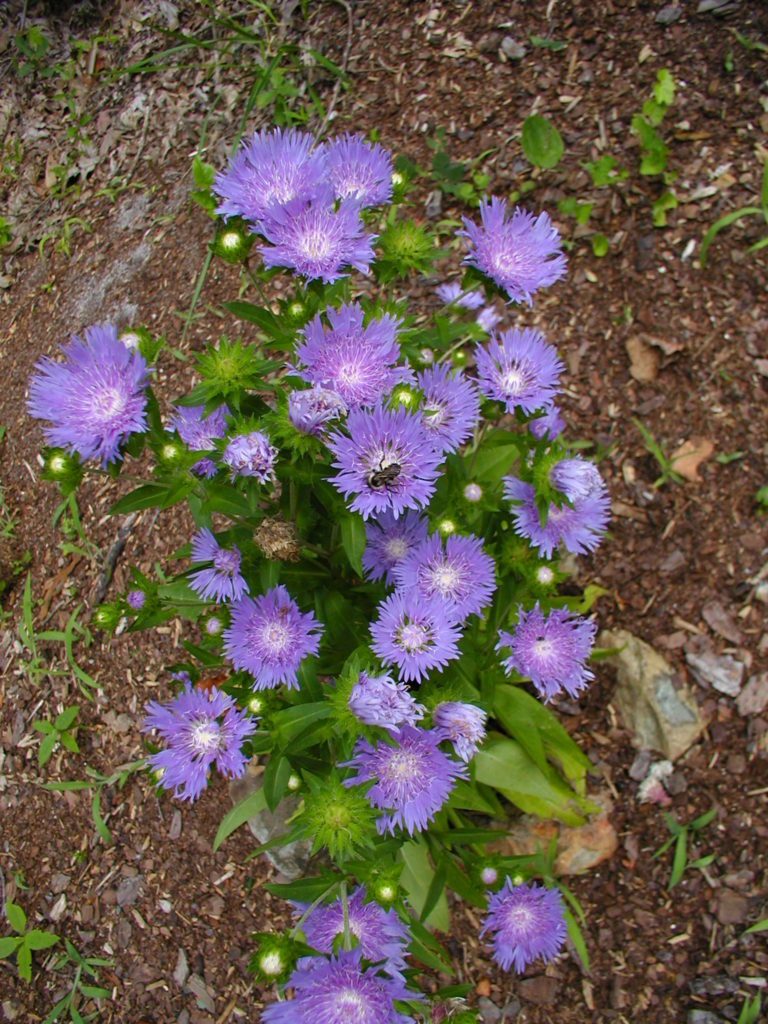This super-attractive, butterfly-drawing herbaceous perennial is small (1-2′ high x 1-2′ wide) with large (2-3 inch) very showy, usually single flowers ranging from cornflower blue (most often) to lavender and even, occasionally, white. The flower structure of Stokes aster reflects its membership in the Aster family: deeply notched blue or lavender ray flowers surround a pincushion center of feathery, lighter disc florets with a distinctly frilly effect. They are supported by stems arising from a semi-evergreen to evergreen basal rosette. Stokes Aster thrives in full sun but may droop some in the afternoon heat. Although accustomed to coastal plain bottomlands and wet savannas, it is said to suffer from wet feet in winter (MoBot) and is apparently adapted to well drained conditions as well. It hales from only a few scattered counties in southern SC, Louisisana, Mississippi, Alabama central Georgia and the panhandle of Florida — and is reported in only one county in NC (Guilford Co., not a coastal plain county!). It is threatened by clearing and logging; conversion of habitat to pine plantations, pastures, and development. Winter hardy to zone 5, well north of its native range.
NURSERY HOURS
Wednesday: 10-4 Thursday: 10-6 Friday-Saturday: 10-4 Sunday: 12-4
Stokesia laevis

Key Info
Scientific Name: Stokesia laevis (Hill) Greene
Common Names: Stokes Aster, Blue Stokesia
Family Names: Asteraceae (Composite, or Daisy Family)
Plant Type: Herbaceous perennial
Leaf Retention: Semi-evergreen
Flower Color: Blue, Lavender, White
Additional Info
Habit: Flower-bearing stems arise from an evergreen basal rosette of dark green lance-shaped leaves. Tap root and short rhizomes.
Height: 1' to 2'
Spread: 1' to 2'
Soil Conditions: Moist, rich, well-drained soil, acidic sands preferred.
Leaves: Basal leaves up to 12 inches long x 2 inches wide, with entire margins, fleshy, evergreen, with tiny glands, and with wings on the petioles. Stem leaves alternate, lance-shaped, 3-5 inches long, with rolled edges, clasping the stem.
Flowers (or reproductive structures: 2 -3 inches wide (some report 4 inches), held at the tips of long, leafy stalks; with whorls of leafy, spiny bracts beneath the head; ray flowers up to 1¼ inch long, blue, lavender, or white, with 5 deeply cut lobes at the tip; inner disk flowers up to ¾ inch long, tubular, blue or white. Both disk and ray flowers, are fertile and bisexual. The flowers must be cross-pollinated in order to produce seed.
Fruit: About 2 months after flowering, seeds (less than 3/8 inch long, greenish-white, shiny, 3- or 4-sided maturing to brown) achenes are formed, surrounded by papery bracts.
Natural Distribution: Wet pine savannas and flatwoods, seeps, wet ditches, pitcherplant bogs on the coastal plain.
USDA Hardiness Zone: 5 to 9
USDA Wetland Indicator Status in NC: FAC
Pollination: Probably pollinated by butterflies and bees.
Wildlife Connections: Moderate deer resistance. Butterflies and bumblebees are attracted by nectar of the blooms in the summer.
Propagation: Division in spring, root cuttings in spring, seed.
